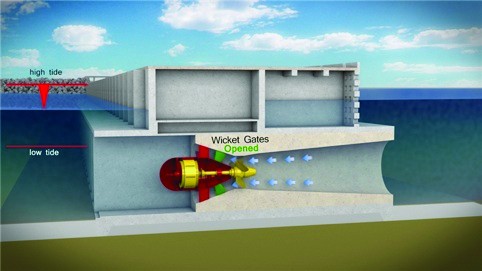Plans to develop a tidal lagoon power station big enough to supply every home in Wales have taken a step forward with the announcement of the project developer, Tidal Lagoon Power (TLP), has secured a grid connection for the 3240MW station. Located between Cardiff and Newport, the tidal lagoon is projected to be the first full-scale deployment of this technology, following on from a pilot scheme planned for Swansea Bay.

The Swansea scheme is now fully-consented and awaiting final sign off from the government, a decision which is expected within weeks, but TLP is keen to secure the next phase of its plans. Although it does not expect to submit a full application for development consent for the Cardiff Bay tidal project until 2019, it has been working on advance plans for three years and has now accepted an offer for grid connection from National Grid Electricity Transmission plc.
“Our offer to the UK government is to contract Swansea Bay Tidal Lagoon for a lower subsidy per megawatt hour than Hinkley Point C,” said TLP’s chief executive Mark Shorrock. “While we await the government’s response to this offer and to the independent Hendry Review of tidal lagoons, we have continued our development work on the subsequent programme.
“Today we have secured the grid connection for a tidal power station equal in installed capacity to Hinkley Point C. Looking at the pounds per megawatt hour unit cost of new build power stations, nuclear is currently priced in the nineties, the latest offshore wind projects are expected to drop into the seventies and our models show Cardiff Tidal Lagoon beating them all in the sixties.”
The projected Cardiff Bay project comprises a 20.5km breakwater wall enclosing some 70 km2 of the Severn Estuary and housing up to 108 tidal turbines within at least two powerhouses. These would handle flows of some 600million cubic metres of water on each tidal cycle. TLP estimates that over 3000 construction workers will be needed to build the lagoon and its associated systems, supporting a further 8000 jobs in the supply chain in Wales and throughout the UK, with supply contracts potentially worth over £6bn. It is hoping to secure some £8bn of investment to complete the project, and is also working on projects in Colwyn Bay, Bridgwater Bay and West Cumbria, as well as discussing some international projects.
TLP notes that the lagoon can also operate as pumped hydro power, and its agreement with National Grid will allow it to handle up to up to 2,171MW of flexible load from Cardiff Bay. “This could be timed to facilitate the integration of more intermittent wind and solar power and more inflexible nuclear power into the future energy system,” it claims. “A portfolio of geographically dispersed tidal lagoons could further enhance these system benefits.”
TLP was this month announced as one of the winners of The Engineer’s Collaborate to Innovate Awards for its plans for the Swansea Bay pathfinder project, along with partners Atkins and LDA Design. Engineers closely involved with the project will be speaking at the Awards’ associated conference on 7 December in Coventry.




Glasgow trial explores AR cues for autonomous road safety
They've ploughed into a few vulnerable road users in the past. Making that less likely will make it spectacularly easy to stop the traffic for...